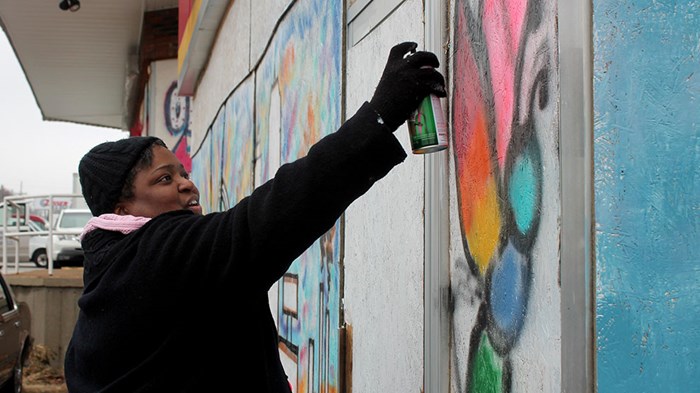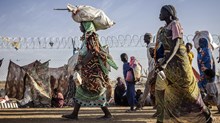
Flames raged so close to Adrienne Hawkins’s home that she thought her neighbor’s backyard was on fire. She could feel the heat and smell the smoke from businesses burning on nearby West Florissant Avenue, a central road running through Ferguson, Missouri.
Hawkins, 46, a Ferguson resident for most of the past 27 years, pulled away from the window. She replied to messages from concerned friends to assure them that she was fine, despite the riots. Meanwhile, her mom baked sweet potato pies for Thanksgiving while her 20-year-old twins played Xbox games.
“It was faith that allowed me to leave the window and do other things,” Hawkins said. “Even though the fires were aglow, we went to bed, because we knew everything would be okay and we would rebuild.”
The rest of Ferguson didn’t sleep that night. It was November 24, the day the news broke that police officer Darren Wilson would not be indicted in the August shooting death of Michael Brown. In response, rioters destroyed and burglarized buildings, leaving a trail of damage along West Florissant.
This is the Ferguson featured on TV for the past five months—the warzone of burning buildings, militarized police, and angry protesters. But it’s not the Ferguson that Hawkins and many other residents know as home.
St. Louis is no longer in an official state of emergency. The news cameras and protestors have trickled away. And many Ferguson residents—including Christians—are determined to rebuild.
In It for the Long Haul
Hawkins is one of them. She’s a Christian who attends Friendly Temple Missionary Baptist Church, a 60-year-old congregation on Dr. Martin Luther King Drive in north St. Louis, where Michael Brown’s funeral was held.
Hawkins is one of the primary organizers of ONE Ferguson, a community group “built by residents for residents.” She says the group is unique in that it comprises Ferguson residents working toward systemic improvement rather than outsiders trying to impose their own solutions.
ONE Ferguson sprouted from the many community meetings held in the city of 21,000 since Brown’s death. As Hawkins and other organizers attended more meetings, they started to recognize familiar faces. Those residents met on their own to discuss solutions, soon growing from a handful of people to a 23-person steering committee. At an October Ferguson City Council meeting, ONE Ferguson officially introduced their organization to the community.
Together the group identified three C priorities of development: community, commerce, and children. Hawkins notes that ONE Ferguson, unlike other St. Louis groups, is diverse—both white and black—and meets in neutral areas rather than historic downtown Ferguson (traditionally white) or West Florissant (traditionally black).
“There is this blossoming sense of community,” Hawkins said. “It’s not the warzone you see on the news. There are real people here. They’re hurting, but they’re reaching out.”
ONE Ferguson is not a faith-based organization. “We’re called to work with everybody,” says Marc DeSantis, a church worship leader on ONE Ferguson’s steering committee. But like DeSantis, many participants are Christians. And there are at least two pastors, a deacon, a worship leader, and a theology teacher on the steering committee. Other pastors have endorsed the group.
Every once in a while, the faith in Christ that drives many ONE Ferguson leaders comes through. At a November meeting, for example, a Presbyterian pastor led a corporate prayer. “It was moving, and so necessary,” said DeSantis.
At three months old, with about 100 people involved, ONE Ferguson is in the planning and brainstorming stage. The group has hosted cleanup days and supported community resource fairs to address short-term needs, while holding focus groups at churches and community centers to discuss long-term ones.
This month, five focus groups are meeting to brainstorm ideas for 1) police and court reform; 2) community relations and development; 3) economic development; 4) citizenship support and progress; and 5) resident education advocacy.
A recent focus group met at the Ferguson Community Center, a relatively neutral location in a residential area across the street from a horse farm. Fourteen residents gathered—seven white, seven black. By the end of the meeting, residents had volunteered to contact colleges to inquire about scholarships and internships for Ferguson youth.
“That’s the beauty of being resident-led: we’re listening to the residents,” Hawkins said. “We’re giving everybody a sense of accountability, of what they can do. ‘What do you have to offer?’”
Meanwhile, Hawkins and other ONE Ferguson volunteers are checking up on Ferguson businesses affected by the riots and asking what they can do to help them stabilize. There’s a community fund set up just for that—not through ONE Ferguson, but through a partner, St. Stephen’s Episcopal Church in Ferguson, and their community-based ministry, The Vine.
St. Stephen’s rector Steve Lawler created the Ferguson Community Development Fund to help these local businesses (see, for example, its GoFundMe page and a local calendar fundraiser). ONE Ferguson helps identify hurting businesses, whose owners can then apply to the fund. About $5,000 has been raised so far, Lawler said.
One of the pastors and earliest organizers on ONE Ferguson’s steering committee is F. Willis Johnson Jr. of Wellspring Church, a predominantly black United Methodist congregation. Located down the street from the Ferguson Police Department, Wellspring has hosted many critical public conversations with residents over the past few months.
“Much of the leadership and voice [in Ferguson] has been misappropriated to people who are not residents or not vested in the system change of Ferguson,” Johnson said. “You can care and have sympathy, but you’re not embedded.”
Take the protests, which have featured “die-ins” where organizers lie on the floor in silence, and have sometimes seen the police’s controversial use of tear gas. Hawkins and DeSantis said only one Ferguson church is known for hosting protest meetings, and others haven’t been part of organizing demonstrations. Individual pastors have provided a peaceful presence at the protests, they said, but they’re not always speaking officially for their congregations.
Bryce Marner, a youth pastor at Salem Evangelical Free Church in neighboring Florissant, came out to some of the protests, joining a group of clergy present to prevent conflict between police and protestors. But he didn’t see many other pastors from his area.
“It's not that North County pastors don't care,” Marner said. “But we’re exhausted from everyone coming into our community and saying, ‘What are you going to do about it?’ We're here every day.”
That isn’t to say that Ferguson churches don’t participate in protests. Johnson has also been to the protests, and Wellspring Church notably hosted the Moral Monday march in Ferguson on October 13.
Johnson believes there is a time for Christians to prayerfully protest, as he recently wrote in an article for the United Methodist News Service. But he said that’s just one part of Wellspring’s larger response, as a church that has invested in relationships with community institutions like the school district and city government.
“How is it that ministries become institutional pillars, to aid in the empowerment of the community?” Johnson said. “You cannot manufacture ministry. You have to dig deep and cultivate it.”
Wounds That Won’t Heal
Meanwhile, Ferguson residents are carrying the toll the social unrest has taken on their well being. Marva Robinson is president of the St. Louis chapter of the Association of Black Psychologists and attends Wellspring Church. She said that the violence, tensions with police, and media misrepresentation have exacerbated existing mental health issues for some residents.
It doesn’t help that the state of Missouri has made mental health cutbacks without expanding Medicaid, making it difficult for many in the St. Louis area to receive treatment, Robinson said.
“Now it will only be worse,” Robinson said. “We could possibly see the crime rate go up, the high school dropout rate go up, the incarceration rate go up. When you have people who are mentally ill who have no access to care, what do you expect to happen?”
That’s why a dozen psychologists in the association’s St. Louis chapter started offering pro bono services after Brown’s death. Robinson has been counseling many Ferguson residents, including distraught parents who brought their children to Wellspring Church the day after the grand jury announcement.
There, Wellspring held an educational program with local teachers who volunteered, while also providing meals and counseling. It was one of 12 local churches to host an educational program that day, an effort that Wellspring initiated working with local schools.
There’s much more work ahead. The St. Louis Association of Black Psychologists will launch at least four free therapy groups (called emotional emancipation circles) in the coming months. Each group of seven to ten people will meet regularly at Wellspring and other sites to discuss their experiences with racism, oppression, and Ferguson.
Johnson welcomes these efforts as an important way to help Ferguson youth heal long after the news cameras are gone. “They’re showing strength and resiliency now,” he said, “but we don’t know what the full effects will be. That is the most uncomfortable thing to discuss and most challenging to address going forward.”
Ferguson’s Resilient Youth
Local ministries are poised to help. Salem Evangelical Free Church, the home of Marner’s youth ministry, started The Kulture in 2013 to reach North County young adults who weren’t necessarily on other ministries’ radars.
Marner estimates that only about 40 percent of The Kulture’s youth identify as Christian, and 90 percent don’t go to church regularly. And while Salem Evangelical is a small, predominantly white church, their youth ministry is about 70 percent black.
Marner said that at least 10 of their students live within a quarter mile of the Canfield Green apartment complex where Brown was shot. All 60 young adults live within a seven-mile radius of that location, but it’s those at the center who have been the most affected by recent events. After the grand jury decision, students living close to the apartments couldn’t leave their homes without being questioned by the National Guard, Marner said.
“The street they call their home was taken over by officers with machine guns,” Marner said. “They don’t grasp all the craziness yet. Later in life, they might realize, ‘Wait a minute, that was crazy and a little messed up.’”
Throughout the unrest in Ferguson, The Kulture has been organizing cleanups and get-togethers while continuing their weekly fellowship and one-on-one student meetings. Recently the group has talked about about everything from Jesus’ influence on how they respond to Ferguson, to resisting the temptation to partake in riot burglaries, Marner said.
Young adults in The Kulture range from mature Christians to curious nonbelievers. Marner said he believes that a handful of students from The Kulture burglarized stores during riots, but that they also came out to clean up the aftermath. “They might not confess, but it’s a huge step to show up and clean up the next day,” Marner said.
During the first round of cleanups, students struck up conversations with shop owners—sometimes offering to pray for them. At first, it felt a little awkward, said high school junior Jahmia Collins, a Christian from Ferguson. But then she saw how eagerly the shop owners joined them in prayer.
“It really warmed my heart,” Collins said. No one turned her down.
Ready to Rebuild
The first time that violence erupted in Ferguson, Hawkins feared for her city and her family’s safety. The second time, after the grand jury announcement, her phone was flooded with messages from fellow ONE Ferguson members asking if she was okay. The next day, the other members even tried to get through to her home, but couldn’t because police had closed the area off.
Their effort alone was enough to assure Hawkins that Ferguson would rebuild. “It meant the world to me to know that they were coming, they were trying,” she said. “I was glad to meet people who were just like me.”
Cat Knarr is a writer living in St. Louis and marketing specialist at Liguori Publications. She earlier reported for CT on "The Forgotten Millennials" and Pentecostal renewal in Rwanda. She tweets from @CatKnarr.
Photo used with permission from stlpublicradio.org

Support Our Work
Subscribe to CT for less than $4.25/month


















